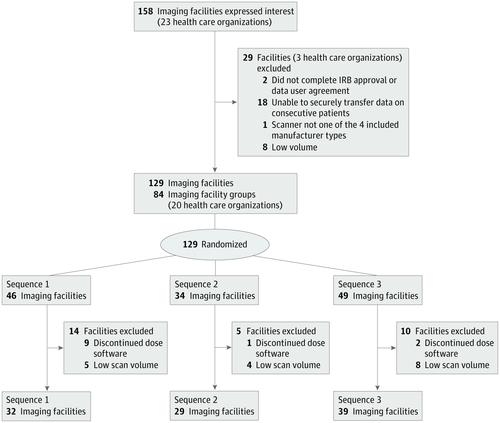当前位置:
X-MOL 学术
›
JAMA Intern. Med.
›
论文详情
Our official English website, www.x-mol.net, welcomes your
feedback! (Note: you will need to create a separate account there.)
Comparison of the Effectiveness of Single-Component and Multicomponent Interventions for Reducing Radiation Doses in Patients Undergoing Computed Tomography
JAMA Internal Medicine ( IF 22.5 ) Pub Date : 2020-05-01 , DOI: 10.1001/jamainternmed.2020.0064 Rebecca Smith-Bindman 1, 2, 3, 4 , Philip Chu 1 , Yifei Wang 1 , Robert Chung 5 , Naomi Lopez-Solano 1 , Andrew J Einstein 6, 7, 8 , Leif Solberg 9 , Luisa F Cervantes 10 , Thomas Yellen-Nelson 11 , William Boswell 12 , Bradley N Delman 13 , Phuong-Anh Duong 14 , Allen R Goode 15 , Nima Kasraie 16 , Ryan K Lee 17 , Rebecca Neill 14 , Anokh Pahwa 18 , Pavlina Pike 19 , Jodi Roehm 20 , Sebastian Schindera 21 , Jay Starkey 22 , Saravanabavaan Suntharalingam 23 , Cécile R L P N Jeukens 24 , Diana L Miglioretti 25, 26
JAMA Internal Medicine ( IF 22.5 ) Pub Date : 2020-05-01 , DOI: 10.1001/jamainternmed.2020.0064 Rebecca Smith-Bindman 1, 2, 3, 4 , Philip Chu 1 , Yifei Wang 1 , Robert Chung 5 , Naomi Lopez-Solano 1 , Andrew J Einstein 6, 7, 8 , Leif Solberg 9 , Luisa F Cervantes 10 , Thomas Yellen-Nelson 11 , William Boswell 12 , Bradley N Delman 13 , Phuong-Anh Duong 14 , Allen R Goode 15 , Nima Kasraie 16 , Ryan K Lee 17 , Rebecca Neill 14 , Anokh Pahwa 18 , Pavlina Pike 19 , Jodi Roehm 20 , Sebastian Schindera 21 , Jay Starkey 22 , Saravanabavaan Suntharalingam 23 , Cécile R L P N Jeukens 24 , Diana L Miglioretti 25, 26
Affiliation

|
Importance
Computed tomography (CT) radiation doses vary across institutions and are often higher than needed. Objective
To assess the effectiveness of 2 interventions to reduce radiation doses in patients undergoing CT. Design, Setting, and Participants
This randomized clinical trial included 864 080 adults older than 18 years who underwent CT of the abdomen, chest, combined abdomen and chest, or head at 100 facilities in 6 countries from November 1, 2015, to September 21, 2017. Data analysis was performed from October 4, 2017, to December 14, 2018. Interventions
Imaging facilities received audit feedback alone comparing radiation-dose metrics with those of other facilities followed by the multicomponent intervention, including audit feedback with targeted suggestions, a 7-week quality improvement collaborative, and best-practice sharing. Facilities were randomly allocated to the time crossing from usual care to the intervention. Main Outcomes and Measures
Primary outcomes were the proportion of high-dose CT scans and mean effective dose at the facility level. Secondary outcomes were organ doses. Outcomes after interventions were compared with those before interventions using hierarchical generalized linear models adjusting for temporal trends and patient characteristics. Results
Across 100 facilities, 864 080 adults underwent 1 156 657 CT scans. The multicomponent intervention significantly reduced proportions of high-dose CT scans, measured using effective dose. Absolute changes in proportions of high-dose scans were 1.1% to 7.9%, with percentage reductions in the proportion of high-dose scans of 4% to 30% (abdomen: odds ratio [OR], 0.82; 95% CI, 0.77-0.88; P < .001; chest: OR, 0.92; 95% CI, 0.86-0.99; P = .03; combined abdomen and chest: OR, 0.49; 95% CI, 0.41-0.59; P < .001; and head: OR, 0.71; 95% CI, 0.66-0.76; P < .001). Reductions in the proportions of high-dose scans were greater when measured using organ doses. The absolute reduction in the proportion of high-dose scans was 6.0% to 17.2%, reflecting 23% to 58% reductions in the proportions of high-dose scans across anatomical areas. Mean effective doses were significantly reduced after multicomponent intervention for abdomen (6% reduction, P < .001), chest (4%, P < .001), and chest and abdomen (14%, P < .001) CT scans. Larger reductions in mean organ doses were 8% to 43% across anatomical areas. Audit feedback alone reduced the proportions of high-dose scans and mean dose, but reductions in observed dose were smaller. Radiologist's satisfaction with CT image quality was unchanged and high during all periods. Conclusions and Relevance
For imaging facilities, detailed feedback on CT radiation dose combined with actionable suggestions and quality improvement education significantly reduced doses, particularly organ doses. Effects of audit feedback alone were modest. Trial Registration
ClinicalTrials.gov Identifier: NCT03000751.
中文翻译:

单组分和多组分干预措施减少接受计算机断层扫描患者辐射剂量的有效性比较
重要性 计算机断层扫描 (CT) 辐射剂量因机构而异,并且通常高于所需剂量。目的 评估 2 种干预措施对 CT 患者减少辐射剂量的有效性。设计、设置和参与者 这项随机临床试验纳入了 864 080 名 18 岁以上成年人,他们于 2015 年 11 月 1 日至 9 月 21 日期间在 6 个国家的 100 个机构接受了腹部、胸部、腹部和胸部联合或头部 CT 扫描。 2017 年。数据分析于 2017 年 10 月 4 日至 2018 年 12 月 14 日进行。干预措施 成像设施仅收到审计反馈,将辐射剂量指标与其他设施的指标进行比较,然后进行多方干预,包括带有针对性建议的审计反馈,a 7 - 每周质量改进协作和最佳实践共享。设施被随机分配到从常规护理到干预的时间交叉点。主要结果和措施 主要结果是高剂量 CT 扫描的比例和设施水平的平均有效剂量。次要结果是器官剂量。使用针对时间趋势和患者特征进行调整的分层广义线性模型,将干预后的结果与干预前的结果进行比较。结果 在 100 个机构中,864 080 名成年人接受了 1 156 657 次 CT 扫描。多成分干预显着降低了使用有效剂量测量的高剂量 CT 扫描的比例。高剂量扫描比例的绝对变化为 1.1% 至 7.9%,高剂量扫描比例的百分比减少为 4% 至 30%(腹部:比值比 [OR],0.82;95% CI,0.77- 0.88;胸部:OR,0.92;95% CI,0.86-0.99;P = 0.03;腹部和胸部合并:OR,0.41-0。59; P<0.001;和头:OR,0.71; 95% CI,0.66-0.76; P < .001)。当使用器官剂量进行测量时,高剂量扫描比例的减少幅度更大。高剂量扫描比例的绝对减少为 6.0% 至 17.2%,反映出整个解剖区域的高剂量扫描比例减少了 23% 至 58%。腹部(减少 6%,P < .001)、胸部(4%,P < .001)以及胸部和腹部(14%,P < .001)CT 扫描的多成分干预后,平均有效剂量显着降低。各个解剖区域的平均器官剂量大幅减少 8% 至 43%。仅审计反馈就减少了高剂量扫描和平均剂量的比例,但观察剂量的减少幅度较小。放射科医生对 CT 图像质量的满意度在所有时期都保持不变且很高。结论和相关性 对于影像设施,CT 辐射剂量的详细反馈结合可行的建议和质量改进教育可显着减少剂量,特别是器官剂量。仅审计反馈的影响是有限的。试验注册 ClinicalTrials.gov 标识符:NCT03000751。
更新日期:2020-05-01
中文翻译:

单组分和多组分干预措施减少接受计算机断层扫描患者辐射剂量的有效性比较
重要性 计算机断层扫描 (CT) 辐射剂量因机构而异,并且通常高于所需剂量。目的 评估 2 种干预措施对 CT 患者减少辐射剂量的有效性。设计、设置和参与者 这项随机临床试验纳入了 864 080 名 18 岁以上成年人,他们于 2015 年 11 月 1 日至 9 月 21 日期间在 6 个国家的 100 个机构接受了腹部、胸部、腹部和胸部联合或头部 CT 扫描。 2017 年。数据分析于 2017 年 10 月 4 日至 2018 年 12 月 14 日进行。干预措施 成像设施仅收到审计反馈,将辐射剂量指标与其他设施的指标进行比较,然后进行多方干预,包括带有针对性建议的审计反馈,a 7 - 每周质量改进协作和最佳实践共享。设施被随机分配到从常规护理到干预的时间交叉点。主要结果和措施 主要结果是高剂量 CT 扫描的比例和设施水平的平均有效剂量。次要结果是器官剂量。使用针对时间趋势和患者特征进行调整的分层广义线性模型,将干预后的结果与干预前的结果进行比较。结果 在 100 个机构中,864 080 名成年人接受了 1 156 657 次 CT 扫描。多成分干预显着降低了使用有效剂量测量的高剂量 CT 扫描的比例。高剂量扫描比例的绝对变化为 1.1% 至 7.9%,高剂量扫描比例的百分比减少为 4% 至 30%(腹部:比值比 [OR],0.82;95% CI,0.77- 0.88;胸部:OR,0.92;95% CI,0.86-0.99;P = 0.03;腹部和胸部合并:OR,0.41-0。59; P<0.001;和头:OR,0.71; 95% CI,0.66-0.76; P < .001)。当使用器官剂量进行测量时,高剂量扫描比例的减少幅度更大。高剂量扫描比例的绝对减少为 6.0% 至 17.2%,反映出整个解剖区域的高剂量扫描比例减少了 23% 至 58%。腹部(减少 6%,P < .001)、胸部(4%,P < .001)以及胸部和腹部(14%,P < .001)CT 扫描的多成分干预后,平均有效剂量显着降低。各个解剖区域的平均器官剂量大幅减少 8% 至 43%。仅审计反馈就减少了高剂量扫描和平均剂量的比例,但观察剂量的减少幅度较小。放射科医生对 CT 图像质量的满意度在所有时期都保持不变且很高。结论和相关性 对于影像设施,CT 辐射剂量的详细反馈结合可行的建议和质量改进教育可显着减少剂量,特别是器官剂量。仅审计反馈的影响是有限的。试验注册 ClinicalTrials.gov 标识符:NCT03000751。











































 京公网安备 11010802027423号
京公网安备 11010802027423号